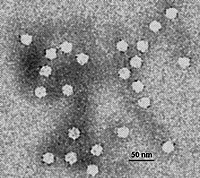Canine parvovirus
| Canine parvovirus | ||||||||||||||||||||||
|---|---|---|---|---|---|---|---|---|---|---|---|---|---|---|---|---|---|---|---|---|---|---|

Canine parvovirus |
||||||||||||||||||||||
| Systematics | ||||||||||||||||||||||
|
||||||||||||||||||||||
| Taxonomic characteristics | ||||||||||||||||||||||
|
||||||||||||||||||||||
| Scientific name | ||||||||||||||||||||||
| Carnivore protoparvovirus 1 | ||||||||||||||||||||||
| Short name | ||||||||||||||||||||||
| CPV-2 | ||||||||||||||||||||||
| Left | ||||||||||||||||||||||
|
The canine parvovirus 2 ( CPV-2 , officially carnivore protoparvovirus 1 ) is a virus which comprises in dogs Parvovirus triggers. The CPV is an unenveloped DNA virus about 18 to 26 nanometers in diameter. In 1978 it was isolated for the first time from dogs with highly acute infections and designated virus type 2 (CPV-2). This designation with the consecutive number 2 comes from the fact that a pathogen that was first described in 1968 as the Minute Virus of Canines (MCV) (alternatively Canines Bocavirus , officially called Carnivore bocaparvovirus 1 ) was incorrectly designated as CPV-1. This MCV only occurred in dogs with mild diarrhea; its pathogenicity is controversial.
Probably the CPV-2 jumped the species barrier and arose - like the virus of the infectious panleukopenia of the marten-like - by mutation from the feline parvovirus (FPV), the trigger of the cat disease . The genetic information encrypted in the FPV is 99% identical to that of the CPV-2.
Mutations in CPV-2, which are characterized by changes in the amino acid sequence in the so-called VP2 protein, were observed shortly after their occurrence. These types, known as CPV-2a and -2b, spread rapidly around the world. CPV-2a and -2b are also infectious again for domestic cats, although the disease here is mostly subclinical . In 2000, another mutant appeared for the first time in Italy (CPV-2c), which has now spread across Europe and to South America.
literature
- Katrin Hartmann and Peter F. Suter: Virus infections . In: Peter F. Suter and Hans G. Nobody (eds.): Internship at the dog clinic . Paul-Parey-Verlag, 10th edition 2006, ISBN 3-8304-4141-X , pp. 276-290.
Individual evidence
- ↑ a b c d e ICTV: ICTV Taxonomy history: Primate erythroparvovirus 1 , EC 51, Berlin, Germany, July 2019; Email ratification March 2020 (MSL # 35)
- ↑ N. James MacLachlan, Edward J. Dubovi (Ed.): Fenner's Veterinary Virology , 5th Edition, 2016, ISBN 978-0-12-800946-8 , doi: 10.1016 / C2013-0-06921-6 . See also Canine Parvovirus , on: ScienceDirekt, left column: Fenner's Veterinary Virology, Laboratory Techniques in Biochemistry and Molecular Biology, 1999
- ^ A. Cavalli et al .: La variation GLU-426 del parvovirus del cane type 2 (CPV-2) è diffusa in Italia. Veterinaria 19, pp. 29-33